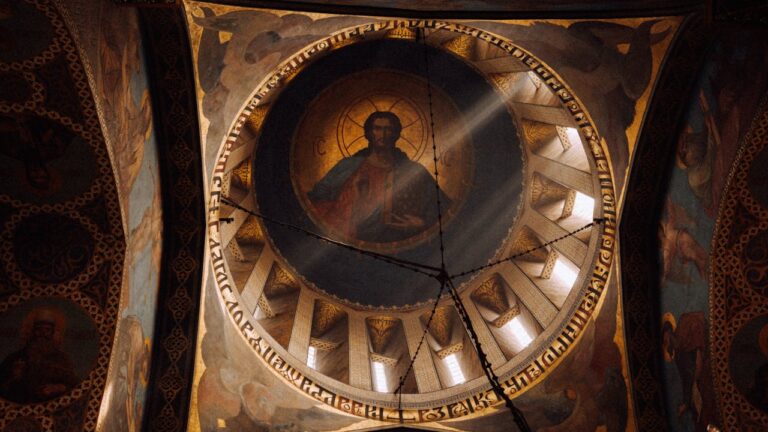1 Enoch naturally divides into five sections: The Book of Watchers (1-36), The Book of Parables (37-71), The Astronomical Book (72-82), the Book of Dream Visions (83-90), and the Letter of Enoch (90-108). Even within these sections, however, there are breaks and subject changes. So let’s do a fairly detailed summary and interpretation of the book.
Chapters 1-11
The Book of Enoch uses the brief verse in Genesis 6:1-5 about the sons of God and the daughters of men intermingling as an allegory for its current situation—presented, anachronistically, by the Old Testament character Enoch. Enoch refers to the sons of men in Genesis 6 as angels, whom he often calls “Watchers,” because they have the task of watching over God’s work. When one understands the struggle of 1 Enoch’s day, one can easily figure out that the “sons of God” represent God’s people, especially their priests, and the “daughters of men” are the pagan Greeks. This union creates bizarre giants, and it corrupts humanity in many ways: astrology, technology, immodesty, pagan worship, sexual immorality, non-kosher foods, etc. God will punish both the Watchers and their offspring, suggesting that there will be wars among them—possibly a reference to the Maccabean wars that left vast destruction in Judea.
Chapters 12-36
This section almost entirely ignores what came before, going backwards in the story to when the corruption of angels and mankind was occurring. This juxtaposition of the two sections may be evidence of two different works conflated together. This second story begins with an attempt to explain the anachronism of why Enoch was present in the time of the Nephilim. We are told Enoch was hidden by God in a cave for a while before being taken up to heaven, and he was sent from the cave to warn the fallen angels that they are going to be judged. The angels ask Enoch to pray to God on their behalf, and God sends an angel to Enoch to say that God does not forgive them, because they had access to holy, spiritual things but lusted after the things of man instead. This should remind us of the Jewish priests who abandoned the sacred things of God to pursue the corrupting ways of the Greeks—a terrible sin because those assigned to watch over Jewish worship were now preventing faithful Jews from worshiping at the Temple faithfully. God promises punishment for the evil, but salvation for the righteous through God’s messiah.
“Those assigned to watch over Jewish worship were now preventing faithful Jews from worshiping at the Temple faithfully.”
Chapters 37-59
Things shift again as Enoch now warns everyone that they will face a day of judgment: sinners will be punished with fire, and the righteous will be rewarded by living with God forever. There is an extended section on a coming messiah, which often alludes to prophecies from Daniel and other prophets. Most notably, this messiah is repeatedly called the “Son of Man,” a title from Daniel 7. Of course, this also is the title Jesus used most often for Himself, which creates a fascinating similarity between 1 Enoch and the Gospels. Rather than suggesting that the Gospels borrowed from 1 Enoch, however, we should understand that 1 Enoch simply indicates that Jews of the time were looking for a messiah they called the “Son of Man,” based on Daniel 7.
Chapters 60-70
In this section, an angel again warns Enoch of judgment to come—on the Leviathan and Behemoth, on the kings of earth and the uncaring wealthy, and on the evil in general. We are also told again about the reward for the righteous. One day all creation will be one with God and praise Him forever and ever. The Son of Man will bring about the kingdom of God in His full power. Noah makes an appearance in this section and discusses with Enoch the flood and the punishment it brings.
“Noah makes an appearance in this section and discusses with Enoch the flood and the punishment it brings.”
Chapters 71-82
This section is entirely about an angel who describes to Enoch in full detail the proper Jewish calendar. The angel warns Enoch that sinners will try to change the calendar, but they will be punished. A simple knowledge of the Second Temple Period is enough to understand this section, as one of the biggest controversies of that time revolved around unfaithful Jews abandoning the Jewish calendar for its Greek counterpart. This struggle over the calendar confirms that the work is about the apostasy occurring in the book’s own time, namely, Jews adopting Greek ways.
Chapters 83-91
In this section, 1 Enoch tries to situate its story into the chronology of the Bible. We find out that Enoch’s knowledge of the Nephilim, rather than coming from his living among them, came to him beforehand in dreams. In his dreams, men are represented by bulls, and part of the punishment of the bulls is that they must fight each other. The fighting bulls bring to mind the Hellenistic and faithful Jews massacring one another during the Maccabean Wars. After this section, Enoch sees various elements of the history of the Jews, with the Jewish people represented by sheep. The story emphasizes how the sheep continually fall away and fight each other, eventually going into exile. It is not difficult to imagine what Enoch means by all this: the unfaithfulness of the Jews during the Babylonian, Persian, and Hellenistic periods. In this way, the storyline of Enoch seems to become more obvious: Enoch is concerned with the struggles of faithful Jews during the Hellenistic period.
“Enoch is concerned with the struggles of faithful Jews during the Hellenistic period.”
Chapters 93-108
This last section includes more discussion of wickedness and judgment to come, along with Enoch’s warnings to future generations. There are more discussions of the coming Messiah, who will bring all people to righteousness and life in the house of God. This is associated with a great judgment and a new heaven and new earth, where sin is no longer found. Enoch weeps over future generations and tells the people who are righteous to be faithful and hold on to their hope because they will be rewarded. In this section, 1 Enoch explicitly describes elements of Greek culture and warns everyone to have no affiliation with them. The section ends with a reference to the Septuagint, as part of the translating of God’s books into other languages so more can follow God. This tells us that at least this section was written after the earliest forms of the Septuagint.
1 Enoch is long and detailed, but it is important for modern readers to remember that it is apocalyptic, that is, poetic analogy. The work is fiction, containing many repetitions and literary non sequiturs which demonstrate, as noted above, that 1 Enoch is not one book, but rather, a collection of different works which deal with the same general themes. What holds the collections together is the apocalyptic style, the common theme of resisting Hellenism, and the fascination with the Old Testament character Enoch, who, you’ll remember, “walked with God, and he was not, for God took him” (Genesis 5:24, ESV).
“The work is fiction, containing many repetitions and literary non sequiturs which demonstrate, as noted above, that 1 Enoch is not one book, but rather, a collection of different works which deal with the same general themes.”
There are other Enoch traditions that did not make it into 1 Enoch, but which pop up elsewhere: in the pseudepigraphal book of Jubilees and in 2 and 3 Enoch. That there were so many Enoch traditions in the Intertestamental period proves that Enoch was a popular guy and that people loved making him the heroes of their stories. And the veiled theme of the threat of Hellenism was a popular theme during this period, as with the Apocrypha. Enoch’s use of the Nephilim as a stand-in for corrupt priests is appropriate, since the corruption of the priesthood was the ultimate offense to faithful Jews, as well as the source of conflict and wars.











